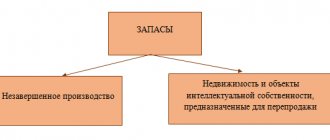PBU 05/01 “Accounting for inventories”: basic provisions
One of the main Russian regulations for regulating the accounting of inventories is PBU 05/01 (approved by order of the Ministry of Finance of Russia dated 06/09/2001 No. 44n). It, in particular, provides a definition of MPZ (clause 2 of PBU 05/01). They represent assets:
- involved in the production of goods, performance of work or provision of services as raw materials or supplies;
- intended for sale (finished products, goods purchased from a supplier);
- used to meet the needs of the enterprise.
IMPORTANT! From 2021, PBU 5/01 will no longer be in force. It will be replaced by FSBU 5/2019 “Reserves”. The norms of this FSBU differ significantly from the provisions of PBU 5/01. The new standard must be applied starting with reporting for 2021. You can start applying the standards earlier.
ConsultantPlus experts explained in detail how to switch to inventory accounting in accordance with FAS 5/2019. Get trial access to K+ and upgrade to the Ready Solution for free.
Inventory accounting units can be:
- stock item number;
- the consignment;
- group of homogeneous materials;
- another unit of accounting determined by the organization and allowing to ensure the reflection of reliable information about inventories, as well as to establish control over their availability and movement.
IMPORTANT! The norms of PBU 05/01 do not apply to work in progress balances, although data on them is included in line 1210 “Inventories” of the balance sheet form.
For information on how work in progress balances are included in line 1210, read the article “Main production in the balance sheet (nuances)” .
The key issues discussed in PBU 05/01 are the assessment of inventories when accepting them for accounting and disposal, as well as the rules for reflecting data about them in accounting records.
I. General provisions
1. These Regulations establish the rules for the formation in accounting of information about the organization’s inventories. An organization is further understood as a legal entity under the laws of the Russian Federation (with the exception of credit organizations and budgetary institutions).
2. For the purposes of these Regulations, the following assets are accepted for accounting as inventories:
- used as raw materials, materials, etc. in the production of products intended for sale (performance of work, provision of services);
- intended for sale;
- used for the management needs of the organization.
Finished products are part of inventories intended for sale (the final result of the production cycle, assets completed by processing (assembly), the technical and quality characteristics of which comply with the terms of the contract or the requirements of other documents, in cases established by law). Goods are part of inventories acquired or received from other legal entities or individuals and intended for sale.
3. The accounting unit for inventory is selected by the organization independently in such a way as to ensure the formation of complete and reliable information about these inventories, as well as proper control over their availability and movement. Depending on the nature of inventories, the order of their acquisition and use, a unit of inventories can be an item number, a batch, a homogeneous group, etc.
4. This Regulation does not apply to:
- assets used in the production of products, performance of work or provision of services or for the management needs of the organization for a period exceeding 12 months or the normal operating cycle, if it exceeds 12 months;
- assets characterized as work in progress.
Accounting for the capitalization of inventories according to PBU 05/01
The procedure under consideration involves the acceptance of inventories for accounting at their actual cost, consisting of the costs of purchasing or manufacturing materials minus VAT and other taxes, which are returned by the state (unless otherwise provided by law).
Here are examples of costs that form the actual cost of inventories purchased from a third party:
- payment under the supply agreement;
- expenses for consulting services provided during the acquisition of inventories;
- customs duties;
- taxes that are not refundable from the budget;
- intermediary remuneration;
- fare;
- expenses for insurance of inventories, etc.
In general, eligible costs can include any costs that are associated with the purchase of inventory from a supplier.
The actual cost of inventories produced independently is determined based on the actual costs associated with the release of the corresponding stocks. Accounting and formation of these costs is carried out in the manner established by the accounting policy for calculating the cost of manufactured products.
If a company conducts accounting according to a simplified scheme, it can:
- Evaluate purchased inventories at the supplier's price, including associated costs as expenses immediately as they are implemented (clause 13.1 of PBU 5/01).
- Being a micro-enterprise, immediately upon acquisition, include in expenses the cost of inventories used in the normal activities of this enterprise (clause 13.2 of PBU 5/01). This method is also available to other organizations with simplified accounting, but only in a situation where their activities do not generate significant inventory balances.
- Immediately write off as expenses all expenses for the purchase of inventories for management needs, including their cost determined by the supplier (clause 13.3 of PBU 5/01).
If the materials and materials do not belong to the company, but it disposes of them in accordance with the terms of the contract, the materials are taken into account in the assessment provided for in this contract.
PBU 5/01
5. Inventories are accepted for accounting at actual cost.
6. The actual cost of inventories purchased for a fee is the amount of the organization’s actual costs for the acquisition, with the exception of value added tax and other refundable taxes (except for cases provided for by the legislation of the Russian Federation).
The actual costs of purchasing inventories include:
amounts paid in accordance with the agreement to the supplier (seller);
amounts paid to organizations for information and consulting services related to the acquisition of inventories;
customs duties;
non-refundable taxes paid in connection with the acquisition of a unit of inventory;
remunerations paid to the intermediary organization through which inventories were acquired;
costs for the procurement and delivery of inventories to the place of their use, including insurance costs. These costs include, in particular, costs for the procurement and delivery of inventories;
costs of maintaining the procurement and warehouse division of the organization, costs of transport services for the delivery of inventories to the place of their use, if they are not included in the price of inventories established by the contract;
accrued interest on loans provided by suppliers (commercial loan);
interest on borrowed funds accrued before the inventory was accepted for accounting, if it was raised for the acquisition of these inventories;
costs of bringing inventories to a state in which they are suitable for use for the intended purposes. These costs include the organization’s costs of processing, sorting, packaging and improving the technical characteristics of received stocks, not related to the production of products, performance of work and provision of services;
other costs directly related to the acquisition of inventories.
General and other similar expenses are not included in the actual costs of purchasing inventories, except when they are directly related to the acquisition of inventories.
The paragraph has been excluded from the financial statements since 2007 by Order of the Ministry of Finance of Russia dated November 27, 2006 No. 156n. – See previous edition.
7. The actual cost of inventories during their production by the organization itself is determined based on the actual costs associated with the production of these inventories. Accounting and formation of costs for the production of inventories are carried out by the organization in the manner established for determining the cost of relevant types of products.
8. The actual cost of inventories contributed as a contribution to the authorized (share) capital of the organization is determined based on their monetary value agreed upon by the founders (participants) of the organization, unless otherwise provided by the legislation of the Russian Federation.
9. The actual cost of inventories received by an organization under a gift agreement or free of charge, as well as those remaining from the disposal of fixed assets and other property, is determined based on their current market value as of the date of acceptance for accounting.
For the purposes of this Regulation, current market value means the amount of money that can be received as a result of the sale of these assets.
10. The actual cost of inventories received under contracts providing for the fulfillment of obligations (payment) in non-monetary means is recognized as the cost of assets transferred or to be transferred by the organization. The value of assets transferred or to be transferred by an organization is established based on the price at which, in comparable circumstances, the organization usually determines the value of similar assets.
If it is impossible to determine the value of assets transferred or to be transferred by an organization, the value of inventories received by the organization under agreements providing for the fulfillment of obligations (payment) in non-monetary means is determined based on the price at which similar inventories are purchased in comparable circumstances.
11. The actual cost of inventories, determined in accordance with paragraphs 8, 9 and 10 of these Regulations, also includes the actual costs of the organization for the delivery of inventories and bringing them into a condition suitable for use, listed in paragraph 6 of these Regulations .
12. The actual cost of inventories, in which they are accepted for accounting, is not subject to change, except in cases established by the legislation of the Russian Federation.
13. An organization engaged in trading activities may include the costs of procuring and delivering goods to central warehouses (bases), incurred until they are transferred for sale, as part of sales costs.
Goods purchased by an organization for sale are valued at their cost of acquisition. An organization engaged in retail trade is allowed to evaluate purchased goods at their selling price with separate consideration of markups (discounts).
14. Inventories that do not belong to the organization, but are in its use or disposal in accordance with the terms of the contract, are taken into account in the assessment provided for in the contract.
15. The item has been excluded from the financial statements since 2007 by Order of the Ministry of Finance of Russia dated November 27, 2006 No. 156n. – See previous edition.
Valuation of reserves upon disposal according to PBU 05/01
Another inventory accounting procedure regulated by PBU 05/01 is their assessment upon disposal. It can be carried out based on:
- from the cost of a unit of material stock;
- average cost of inventories;
- the cost of the very first purchased inventories - using the FIFO method.
If inventories are used by a company in a special manner or are not interchangeable in normal use, they can be valued based on the cost of each unit of inventory.
If the accounting policy defines a specific method of accounting for inventories for the reporting year, only this method should be used during the corresponding period. The method of accounting for inventories is selected based on its applicability to the activities carried out by the legal entity.
The assessment of inventories that do not relate to goods, which are recorded at sales value, as of the end of the reporting period is carried out in the same way as is used when disposing of the corresponding inventories.
III. Release of inventories
16. When releasing inventories (except for goods accounted for at sales value) into production and otherwise disposing of them, they are assessed in one of the following ways:
- at the cost of each unit;
- at average cost;
- at the cost of the first acquisition of inventories (FIFO method);
- at the cost of the most recent acquisition of inventories (LIFO method).
The application of one of the specified methods for a group (type) of inventories is based on the assumption of consistency in the application of accounting policies.
17. Inventory inventories used by the organization in a special manner (precious metals, precious stones, etc.), or inventories that cannot normally replace each other, can be valued at the cost of each unit of such inventories.
18. The assessment of material and industrial inventories at average cost is carried out for each group (type) of inventories by dividing the total cost of the group (type) of inventories by their quantity, consisting respectively of the cost price and the amount of balance at the beginning of the month and the inventory received during the given month.
19. Estimation at the cost of the first acquisition of inventories (FIFO method) is based on the assumption that inventories are used within a month or another period in the sequence of their acquisition (receipt), i.e. inventories that are the first to enter production (sale) must be valued at the cost of the first acquisitions, taking into account the cost of inventories listed at the beginning of the month. When applying this method, the assessment of inventories in stock (in warehouse) at the end of the month is made at the actual cost of the latest acquisitions, and the cost of goods sold, products, works, services takes into account the cost of earlier acquisitions.
20. Valuation at the cost of the last acquired inventories (LIFO method) is based on the assumption that the inventories that are the first to enter production (sale) should be valued at the cost of the last in the acquisition sequence. When applying this method, the assessment of inventories in stock (in warehouse) at the end of the month is made at the actual cost of early acquisitions, and the cost of goods sold, products, works, services takes into account the cost of late acquisitions.
21. For each group (type) of inventory during the reporting year, one valuation method is used.
22. Valuation of inventories at the end of the reporting period (except for goods accounted for at sales value) is carried out depending on the accepted method for valuing inventories upon disposal, i.e. at the cost of each unit of inventory, the average cost, the cost of the first or last acquisitions.
Reflection of inventories in financial statements according to PBU 05/01
PBU 05/01 also regulates the procedure for reflecting information about inventories in accounting reports. Inventories should be reflected in it in accordance with a classification that takes into account the method of their use in economic activities.
As of the end of the reporting year, inventories are shown on the balance sheet at cost, which is established based on the methods used to evaluate the corresponding reserves.
Materials and equipment that are obsolete or have lost their marketable appearance or have become cheaper are reflected in the balance sheet at the end of the year minus the reserves provided for the reduction in the value of inventories. The corresponding reserve is formed at the expense of financial results by the amount of the difference between the market value and the actual cost of inventories if the second indicator is higher than the first. This norm may not be followed by companies that conduct simplified accounting (clause 26 of PBU 5/01).
Inventory that is in transit or transferred to the consumer as collateral, the rights to which have been transferred to the legal entity, are reflected in accounting based on the assessment provided for in the contract, with further clarification of their actual cost.
The following must be included in inventory accounting:
- methods for assessing MPZ in relation to their groups or varieties;
- information about the consequences of changes to these assessment methods;
- the cost of inventories pledged as collateral;
- the amount and movement of reserves for reducing the cost of materiel.
For information on how management accounting for inventories is organized, read the article “Management accounting of inventories (nuances).”
Accounting for asset disposals
The third section of PBU 05 01 “Accounting for inventories” establishes the rules for assessing disposals. There are three ways:
- at the actual cost of a unit of asset;
- according to the average cost of a group of supplies;
- using the FIFO method.
The chosen method of estimating the cost of write-off should be fixed in the accounting policy. After approval of the accounting policy, the method will be applied throughout the entire period of validity of the document. You can change the method of valuation when writing off only from the beginning of the next year.
Has the new PBU 5/2012 “Inventory Accounting” been adopted?
Procedures related to accounting for inventories may be regulated not only by Russian, but also by international reporting standards. First of all, it is worth noting that the legislator made an attempt to adapt IFRS standards to financial and economic legal relations in Russia by developing the draft PBU 5/2012, which was supposed to establish new inventory accounting standards - instead of those defined in PBU 05/01 - taking into account international standards.
However, this project was never adopted. Nevertheless, in 2015, the Russian Ministry of Finance introduced one of the IFRSs into the Russian Federation, regulating the handling of inventories.
The new FSBU 5/2019 brings the standards of IFRS and RAS closer together.
A ready-made solution from ConsultantPlus will help you rebuild the materials accounting algorithm when applying FSBU 5/2019. Get trial access to K+ for free and proceed to the material.
Read about what Russian and international standards have in common and what distinguishes them in the article “RAS and IFRS - main similarities and differences.”
Inventory accounting according to IFRS: governing legislation
We are talking about the adoption of International Standard (IAS) 2 “Inventories”. It was put into effect by order of the Ministry of Finance of the Russian Federation dated December 28, 2015 No. 217n; its text in Russian is given in Appendix 2 to this order.
In this legal regulation, reserves are understood as assets that:
- held for sale in the ordinary course of business of the firm;
- are manufactured in production for the purpose of further sale;
- are in the form of raw materials or materials that are used by the company in production or in the provision of services.
Inventories in IFRS also mean:
- goods purchased by the company for the purpose of further resale;
- finished products;
- remains of work in progress, which are subject to further use by the company during production.
By analogy with the procedures discussed above, regulated by Russian PBU 05/01, we will consider which standards of IFRS 2 can be applied to assess the value of inventories and generate reports on inventories.
Valuation of reserves according to IFRS
In accordance with IFRS 2, inventories should be measured at the lower of the following:
- cost;
- net potential selling price.
As for the cost, it should include the following costs:
- for the purchase of inventories;
- their processing;
- other costs incurred by the company in order to ensure the current location and condition of inventories.
In turn, the costs of acquiring assets include:
- purchase price of the stock;
- duties;
- non-refundable taxes;
- fare;
- costs associated with loading and unloading;
- other costs that are directly related to the purchase of inventories.
In this case, discounts and other reasons for reducing costs must be deducted from the cost of purchasing inventories.
Regarding processing costs, they should include:
- salaries of employees engaged in production;
- various overhead costs when processing raw materials.
Other costs that are taken into account when determining the cost of inventories may include, in particular, the costs of developing certain products for certain customers. Sometimes the cost structure of inventories may include borrowing costs - this procedure is regulated by separate IFRS standards.
Net potential selling price in IFRS is the estimated selling price of an asset in the ordinary course of business less estimated costs of completion and sales.
When inventories are sold, their carrying amount is recognized as an expense in the period in which the firm receives revenue from the related sales. The amount for any write-down of inventories to their net potential selling price, as well as any loss of inventory, must be recognized as an expense within the period in which the write-off or loss was recognized. Amounts for any reversals (of previously written-off inventories) due to an increase in net potential selling price should be recognized as a reduction in the amount of inventories recognized as expenses within the period in which the reversals were made.
Separate standards for determining the cost of inventories are established in IFRS 2 for companies providing services, as well as for farming organizations (paragraphs 19, 20).
When calculating the cost of goods according to IFRS, the following accounting methods can be used:
- on regulatory costs;
- retail prices.
The first method involves looking at typical levels of inventory consumption, labor, efficiency, and productivity - but these can be revised based on market conditions.
The second method is more suitable for retail, an area characterized by frequent changes in the structure of inventories, as well as revenue indicators for their sales or products manufactured using materials.
Inventory reporting in accordance with IFRS
IFRS requires firms to disclose when reporting inventories:
- the principles of the adopted accounting policy regarding the valuation of inventories, as well as the formula for estimating their cost;
- the total cost of all inventories for inventories, as well as specific types of inventories that are used in the organization;
- the carrying amount of inventories, which are accounted for at fair value, but less costs to sell;
- the size of inventories, which are recognized as expenses within the reporting period;
- amounts for any write-offs of the cost of inventories that are recognized as expenses within the reporting period;
- amounts for any reversals of write-offs that are recognized as a decrease in inventory, which is reflected as an expense within the reporting period;
- obligations or events as a result of which the write-off of the cost of inventories was restored;
- the book value of inventories that were pledged as a means of fulfilling the company’s obligations.
Fair value in the context of IFRS 2 is the price that a firm would receive to sell an inventory or pay to transfer a liability in an orderly transaction with a counterparty at the time the asset is measured.
Read about who in the Russian Federation has the obligation to prepare financial statements under IFRS here .






